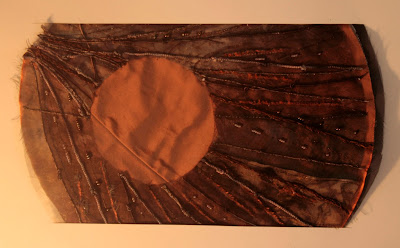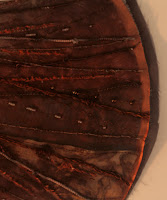And what a lots of possibilities there are and so many as a result of Summer School and the opportunity to discuss this work so far with Sian and where I might take it next.
Alone in my workroom the possibilities juggle one with another: if I take this decision, then that may be the result, on and on in a never ending range of combinations. If you don't actually sample those combinations there is no way of seeing how each one works -- no compare and contrast -- no making a choice of what works best.
When Sian initially told me she thought I wasn't particularly good at making decisions I wasn't completely accepting of the idea. Now I've had some time to digest the thought, I've decided she may well be right. So here then is the ebb and flow of sampling and deciding how my resolved sample should look.
At my tutorial we discussed the smaller complex circle, based on the paper-cuts, and whether it had a place at all as part of the design. Though the colours of this element were in my colour scheme it did jump out as possibly too strong both in colour and texture: it was made of cotton and felt rather than silk and organza, and unlike those I'd dyed neither of them myself. (Interestingly having too broad a colour scheme was the same error I made at Summer School with Flint Brocade.) The way I had tried to integrate the two circles work was by adding fine springs made of cords and clustering beads around them, but it wasn't sufficiently successful to continue along that path. Instead Sian and I talked about cutting into the main circle to reveal the shot silk beneath; this toned much better, but felt rather an extreme action to take.
My next thought was, if I'm going to cut into my piece of work do I need a minor circle at all? I did,with just the knotted cords across somehow the piece seemed to lack any purpose, so to me the minor circle was a must.
Orientation was also a discussion point and we decided not only to turn the piece, but also to crop it.
 |
| Sample 1: Starting Point |
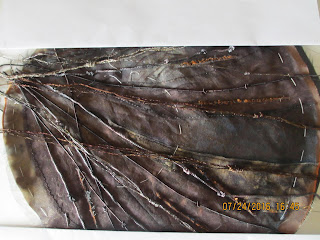 |
| Sample 2 : No circle at all |
Back home and with so much in a state of flux, I sampled different size minor circles: smaller or even smaller and came to the conclusion that the proportions of the original size were in fact just right.
 |
| Sample 3 : Smaller Circle |
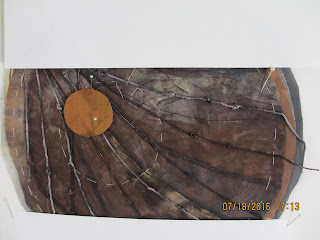 |
| Sample 4: Smallest Circle |
 |
| Sample 5 : Just right |
And still resistant to the idea of cutting through the lovely top circle of carefully dyed, printed and pieced organza I began to explore other possible treatments of my perfectly sized circle, trying printing, trapunto, and printing and trapunto combined. Finally I recreated a circle, like the felt and cotton one but only in shot silk, gradually cutting into it until it needed reconstructing and supporting on another circle resembling by this point a skeleton. This was a wholly unnerving experience.
 |
| Sample 6 : Printed |
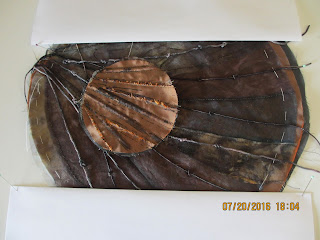 |
| Sample 7 : Printing with Trapunto |
 |
| Sample 8 : Deconstructed and Reconstructed |


